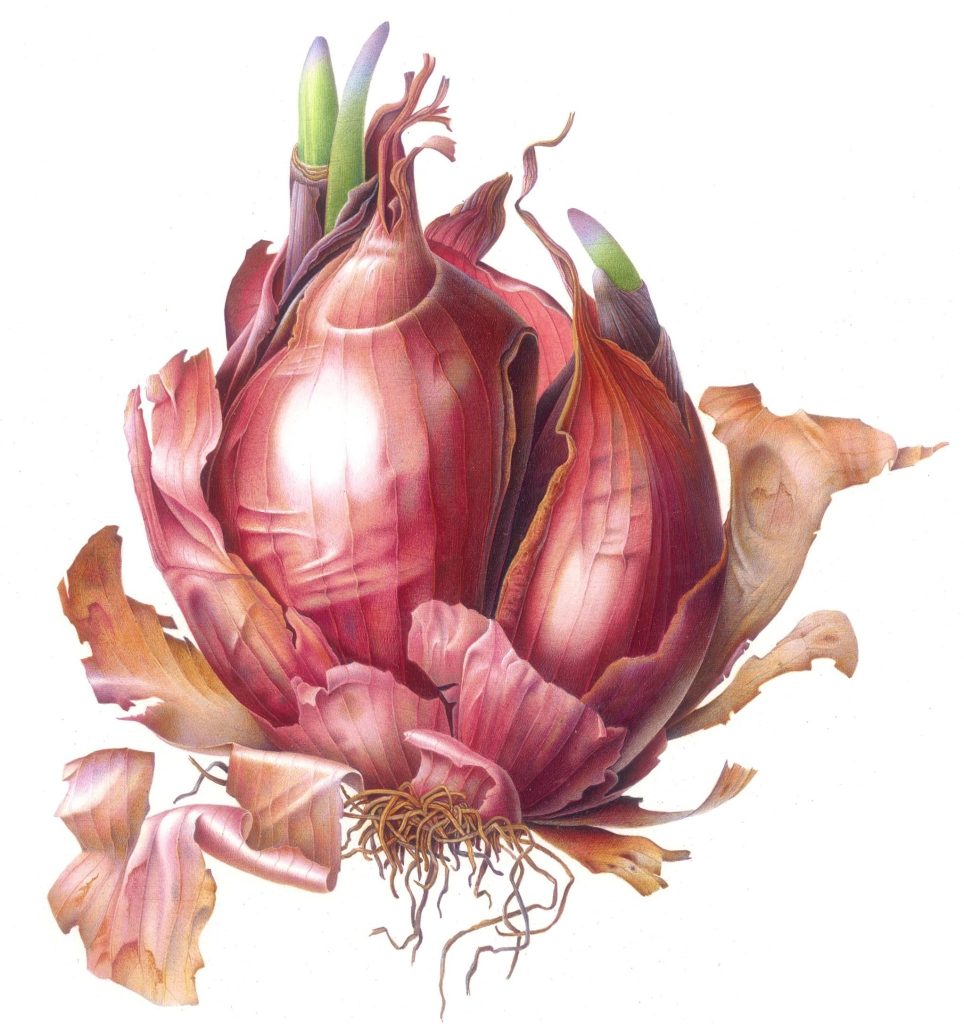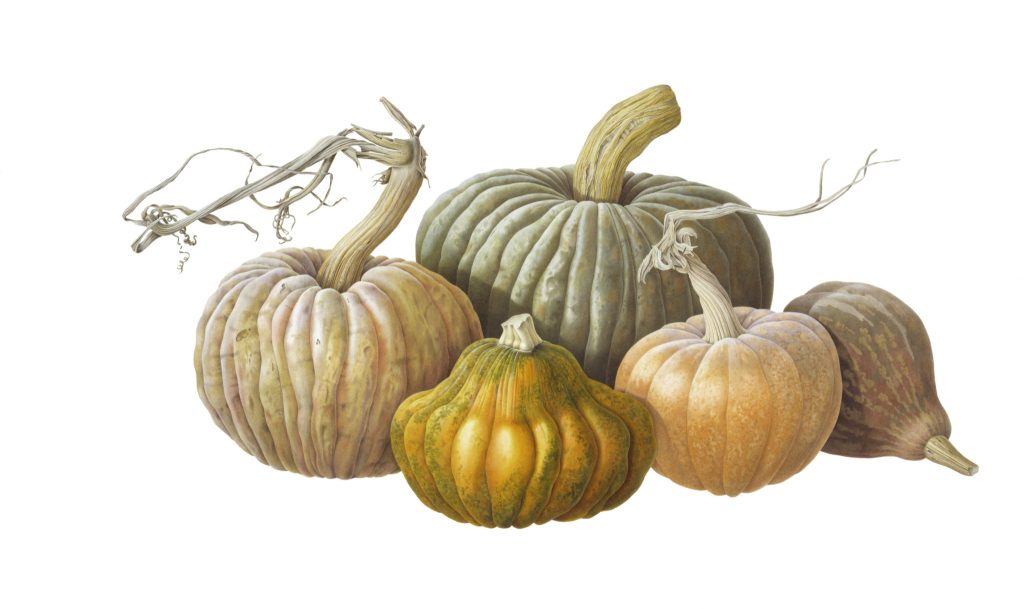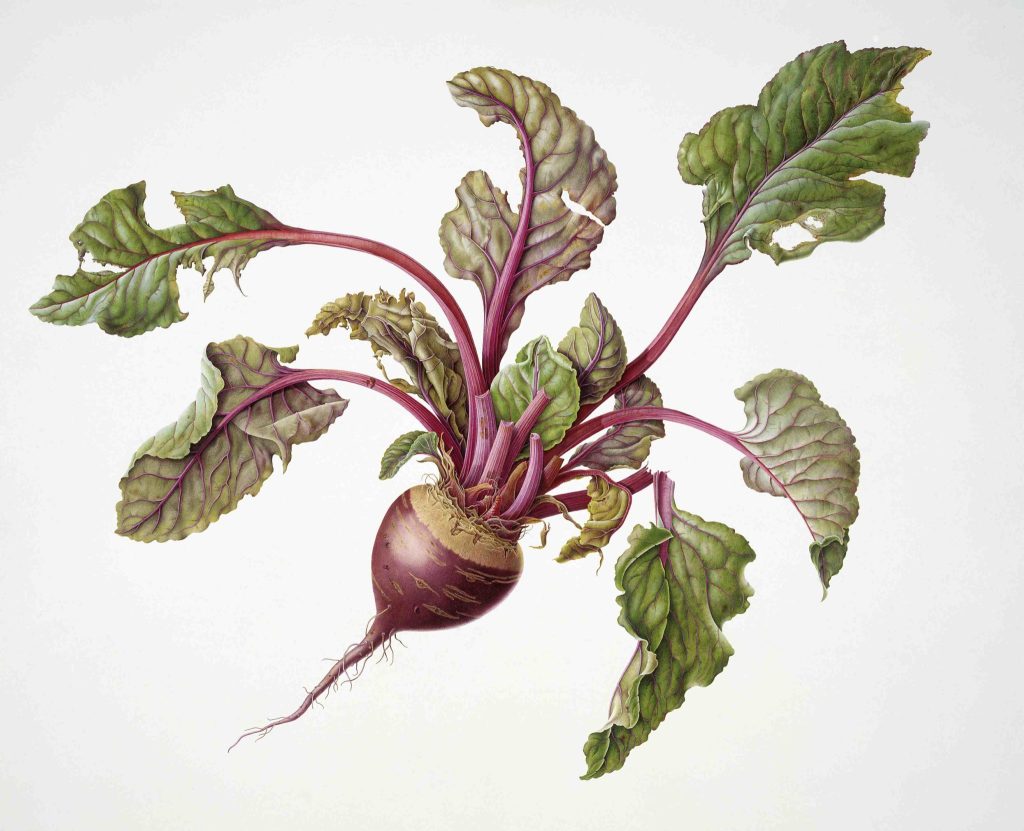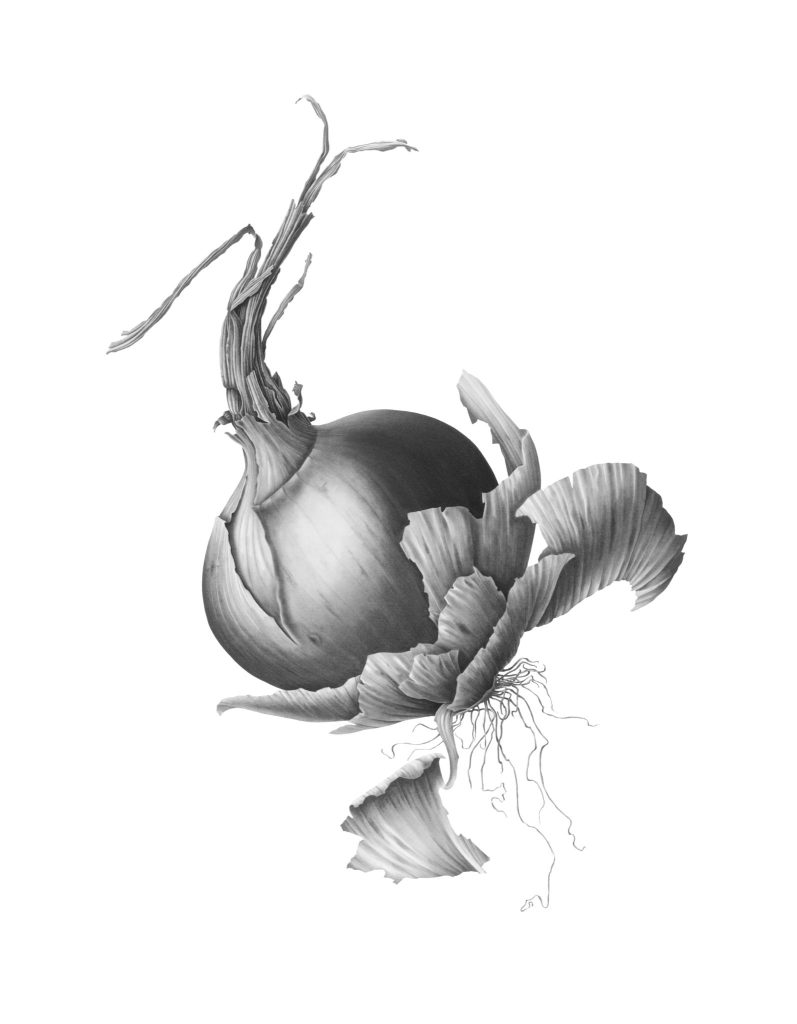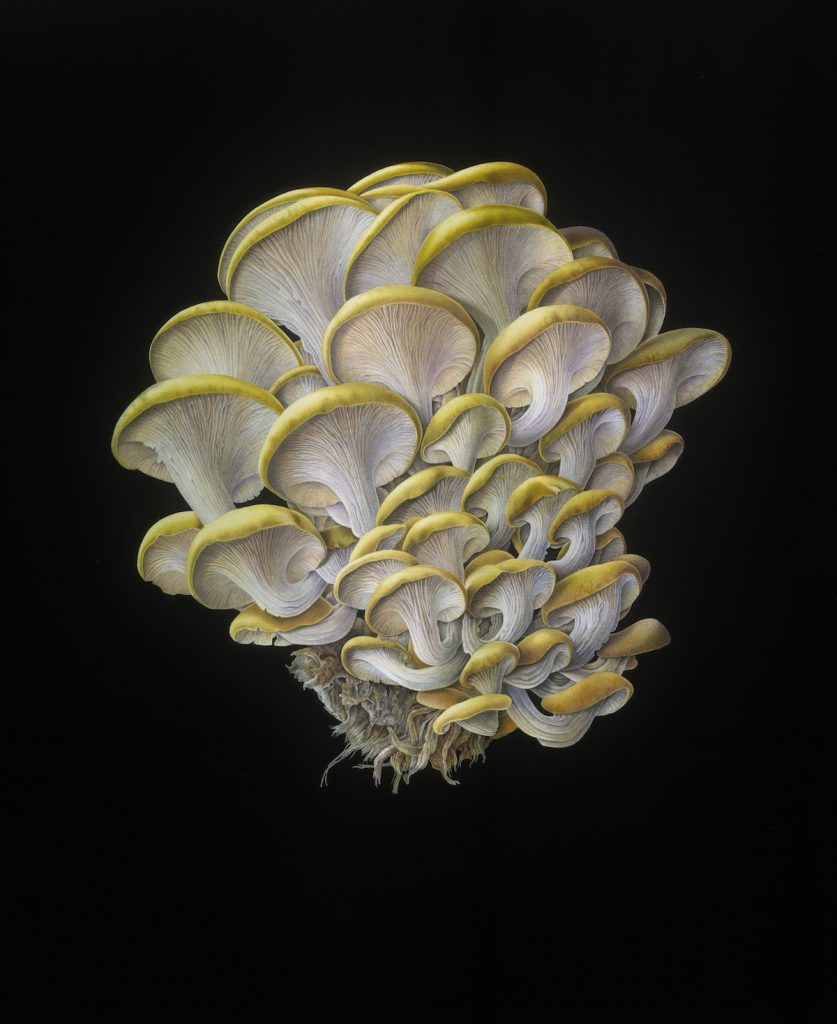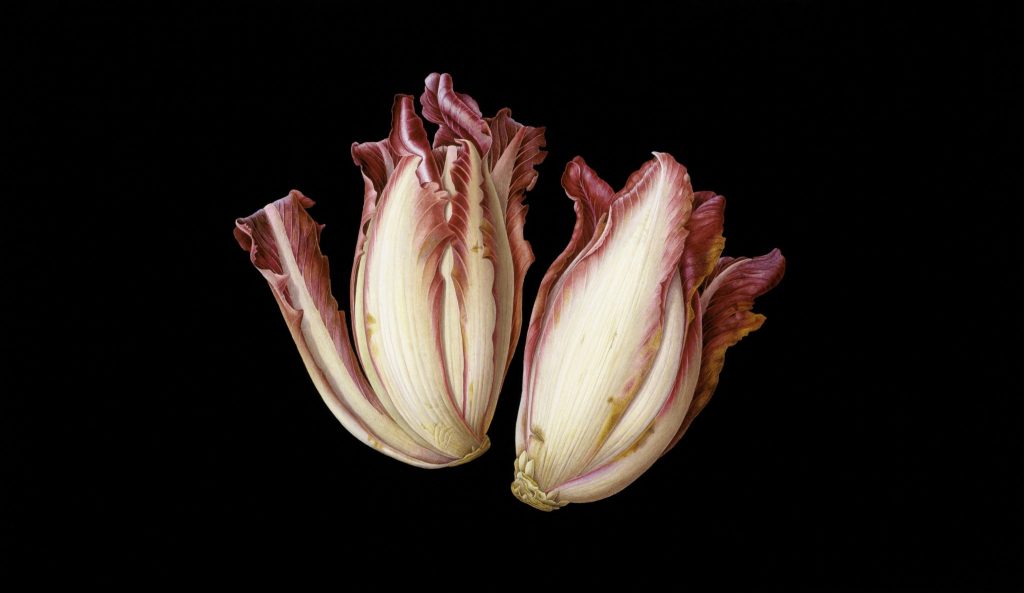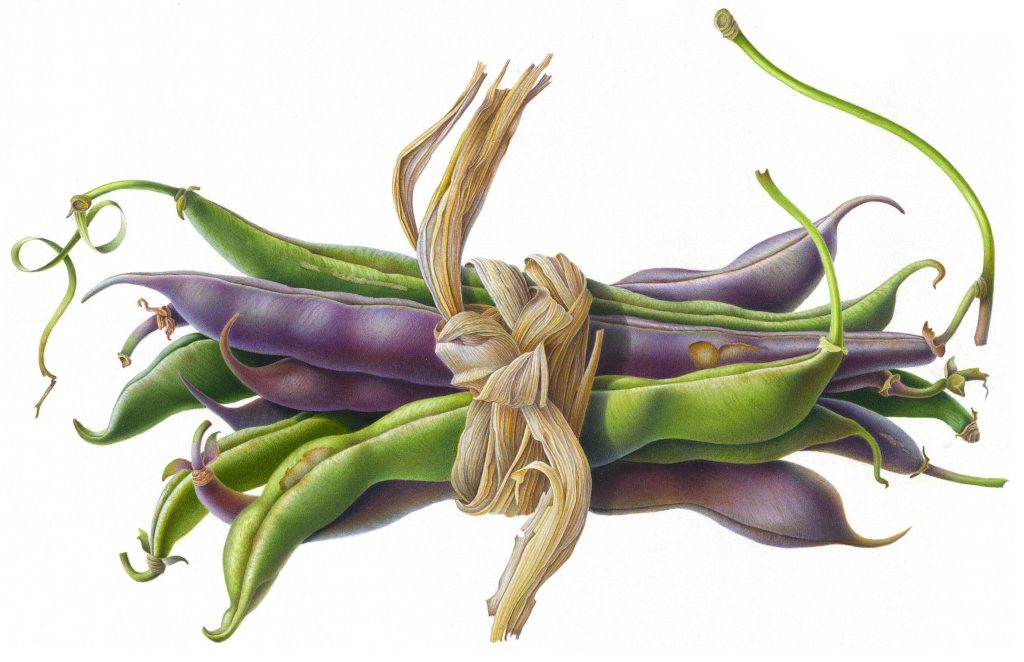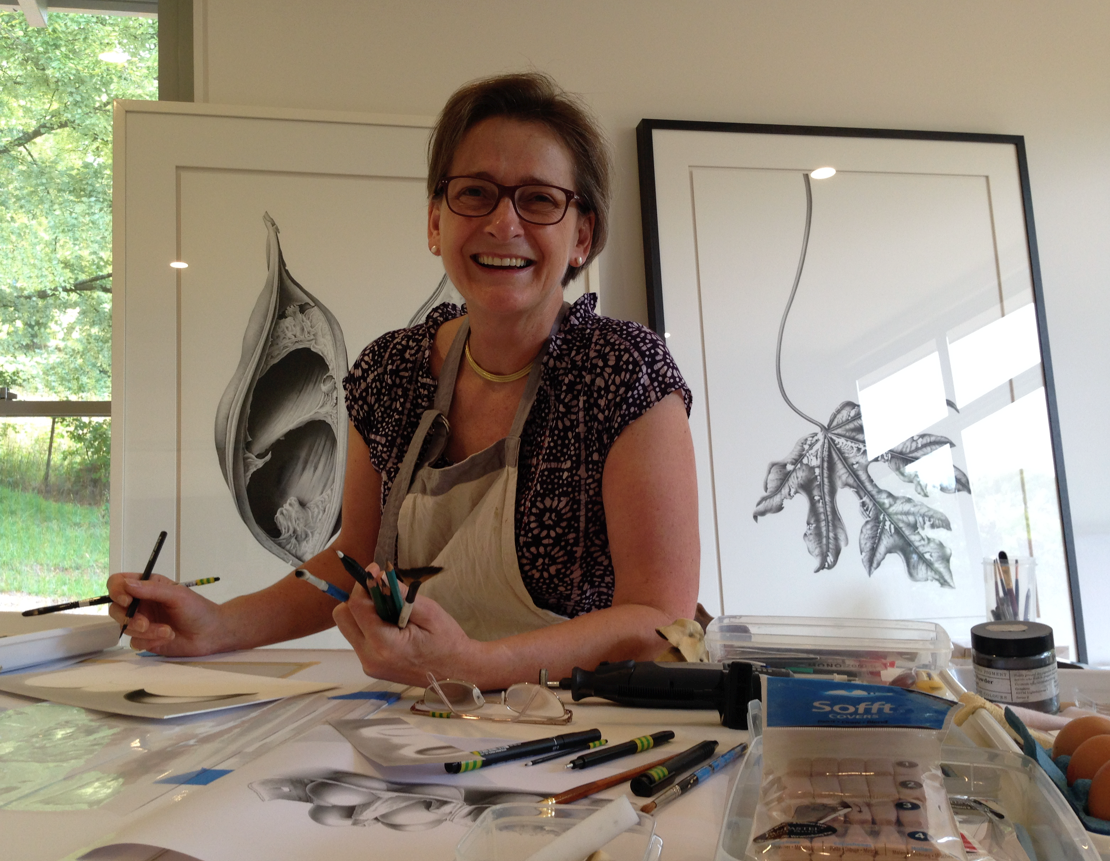Susannah Blaxill Painter
Composition and cropping is very important to your work can you expand on this?
Red Onion on Vellum, 177 x 164mm, Watercolour over pencil on Vellum
Expand on composition with group compositions Group of Pumpkins and Pine Cap Mushrooms?
After looking at all the mushrooms I had purchased for the painting “Group of Brown Mushrooms”, I found it so hard to decide on one subject so decided to paint three that were all similar also very different. I always love subjects from the same “family” that have noticeable difference because it is the differences between the mushrooms that make a group subject much more interesting. The shapes of each mushroom were different as were the colours, and it was this that I noticed first. In the painting of the “Group of Pumpkins”, I was fascinated first by the stalks and tendrils, and then I grouped together pumpkins of different colours, with the heaviest subject at the back, and the lighter colours nestled around the base of the dark green subject. The colours had a creamy quality to them and had such interesting form. As often the subjects float as I felt that shadows would create a visual distraction.
Group of Pumpkins, 380 x 630mm, Watercolour
You take the obvious and create wonder, discuss this in relationship to one or two of your vegetable paintings?
Nothing could really be more ordinary than a single beetroot with its leaves,that is until you have looked at it with a painters’ eye. To me it is neither ordinary, unremarkable nor obvious and I love this subject to paint.
Beetroot 480 x 640mm, Watercolour
I see in it a glorious small world of vibrant colour, movement and form. The extraordinary leaves give a wonderful fluid counterbalance to the woody and gnarled root. For me, painting beetroot is a wonderful exploration of creativity. I am unable to completely leave the colours alone and enjoy so much being able to add more pigment, change the colour bias, create even darker shadows, or bathe parts of the subject in light. I try to do this with all my work if possible. Another subject that I have happy painting memories of is the humble cabbage, which has for centuries been a favourite of painters, despite its limited culinary popularity. In the “Unfinished Cabbage” painting, you can see from the underlying incomplete washes the wonderful range of expressive colours in all the leaves. It would be so easy to ignore these as being too laborious to paint, but it is this gamut of colours that makes the subject so rich, and lifts it out of the “ordinary”. In all my painting endeavours I try very hard to create works that viewers will want to come back to, to view again. Nothing it seems is really ordinary at all.
You now live in the Southern Highlands of NSW, your work is international, discuss briefly how this has happened?
For many years I lived in England, but my country of origin is Australia where my family are and where I was brought up. While in England, I planted a garden in a rather unpromising sandy and very windy field in Norfolk. Knowing little about plants I steeped myself in gardening literature and one of the spin offs of growing all sorts of plants, both flowers and vegetables was that I had time to examine them all in great detail. I had always drawn on and off through my school years but stopped when I embarked on tertiary education. As my gardening and drawing interests became my focus, I began to draw full time. Painting soon followed and then work was accepted into exhibitions in the UK. This was followed by further work and solo exhibitions. My career was thus established in London and I took part in other exhibitions around the world. Where I lived in the world was not really an issue career-wise as long as I continued to accept commissions from abroad and also take part in international exhibitions outside Australia.
Botanical art has changed recently to being art not just a scientific record, discuss.
I find it difficult to know where the actual boundary is between art and illustration, and in most of the workshops that I teach, this discussion always arises. Personally, I feel that I am more of an artist than an illustrator as my interest lies in an expressive approach to everything I draw or paint. I also wonder whether the genre of Botanical Art or Illustration is becoming more popular as many believe. If it has become so, it is because of the focus that has been given to notable private collections, the most important being the Shirley Sherwood collection.
Aged Mushrooms, 130 200mm, Watercolour
When we first corresponded you needed me to wait as you were preparing work for the UK. Can you expand on the differences between the UK and the Australian markets?
There are definite differences between the markets here in Australia, and those in the UK and America, and I believe it is to do with two things. The first is that Australia has a small population when compared to the UK and Europe, and so quite simply there are fewer customers for a specific niche market such as Botanical Art. The second important difference is that the Australian market has no real history of Botanical Art as a genre, whereas in Europe, the history of Botanical is a long and distinguished one. Much of my work over the years has come from abroad but I am delighted to be able to say that the Australian component of my commissioned work is growing each year..
You have a long history with the Kew Gardens discuss this relationship?
I have had a long History with Kew but mostly through my work with Dr Shirley Sherwood, who began purchasing my work at the beginning of my painting career. Dr Sherwood was asked by the gallery who represented me for my first solo show in London to look at my work to assess whether it was sound. She travelled up from Kew, gave the paintings a tick of approval, bought before the exhibition opened and we have had a very happy relationship ever since. I was offered an exhibition at Kew but unfortunately at that time was unable to take up the offer. I do have work in the Kew Collection and my work within the Shirley Sherwood collection appears on show when they fit within the chosen framework for the planned exhibition.
You teach between March and April each year. Can you explain the course you present and the way you work through it with the students?
I enjoy my teaching, and aim to equip students with techniques that they can then take home to practice. I have found over the years that it is more important to give students information and skills that they can build on rather than attempting to encourage them to produce finished paintings. Finished paintings take a long time to produce, and I may only address one or two techniques. It is better for students to be introduced to a range of new techniques. Mostly I teach exercises but it is hard not to address composition at the same time. Sometimes the exercise produces the most startlingly successful small works of art and this is a coup for the student. Even though the student is being taught, much of what is learnt is by trial and error. The errors interestingly are perhaps the best teachers. Demonstration is critical to the students understanding and I do a lot of this. I keep my classes very small – 4 to 6 students only so that there is plenty of time for questions and revision. Although we work quite slowly, I feel it is important that if a student is not having success then the drawing or painting can be put aside without fuss and we move on to something else and try something slightly differently. For all artists it is important to see failure as just a pointer to what needs to be focused on and I believe that as a teacher, students are best lead with a gentle and kind approach but one that is also honest and to the point.
Expand on the way you paint plants in all their life cycles – buds to dying flowers?
Because I am not really a Botanical Illustrator whose work often represents the full life cycle of the plant, I tend to focus on what interests me. Often there are aspects of the life cycle in some of my works, for example in the Camelia painting “Star Above Star”, I have shown both buds and flowers, but generally, this is not what I focus on. I suppose I focus on particular parts of the life cycle rather than wishing to depict each part in one painting.
Camelia “Star above Star” 740 x 510mm, Watercolour and Gouache
Tell about your thoughts on ‘perfection’ and ‘imperfection’ in your work?
For me, it is a massive challenge to paint something that is perfect. I had a commission recently to paint “The Perfect Onion”. I tried to negotiate for some imperfection, but it was the perfection that was the whole point of the commission. It was a very taxing job, as I had to be so careful to get the painting exactly as the subject was in front of my eyes. It is really a challenge to make the perfect subject interesting and it made me realise how much I depended on imperfections in natural subjects to bring the work alive.
Sprouting Onion, 220 x 220mm.
You also draw the skin of plants. Discuss this in relationship to ‘Onion Skin’.
I think that drawing and painting onion skin gives me more pleasure than almost anything else. This is because my mind has to be absolutely focused to be able to do it well. The trick is in seeing the colours where they are and recording exactly that. As the painting progresses it is possible to embellish the colours so as to achieve a hyper realism. This is a great challenge, but one worth attempting as at the end of the day being so focused means that my mind is nowhere else except with the painting – a form of mindfulness meditation I believe, that yields great pleasure. I have also explored onion skin in black and white as I had wondered if it were possible to create the “weightlessness” of onion skin in Charcoal. This was a real challenge and was exciting to execute.
Brown Onion 810 x 610mm Charcoal
Expand on your use of charcoal in your art?
I have a great love for black and white drawings and photographs. I began to use charcoal when searching for a greater depth in my work. Charcoal gives me the means to create dense rich blacks. I am also interested in the nuances of working with charcoal, and really enjoy the contrast between the charcoal and the white paper. It has taken me some time to understand the medium, and progress is always slower if you are self- taught as I was. Every step forward is a new discovery.
Nature produces colour combinations some of these are such a huge surprise can you tell of several of these very interesting finds?
Perhaps the painting of the Gymea Lily best answers this question. Over the years I have seen so many paintings of the Gymea Lily, a very statuesque plant, sometimes with a massive head of flowers. I received a commission to paint it, and was somewhat alarmed as it was to be such a large work in watercolour that would take me over half a year to complete. The colours were fascinating and the more I looked at the subject the more I realised that if I played with the colours, I could make a very interesting painting. As most painters know, green is not just a mix of yellow and blue, and nor is purple a mixture of pink and blue. Rather, the colour field for the Gymea lily seemed to be much more like a rainbow. The brighter the natural light, the more vibrant were the colours. It was an absolute joy to paint as I had so much to play with – very unusual colours were placed side by side, and the greater the differences between the colours, the more interesting the contrasts became.
How difficult do you find buying fruit and vegetables without seeing them all as potential models?
Generally, I shop for the household at great speed, so don’t really stop to gaze. I do however make many specific trips to my local vegetable shops and markets to buy subjects for painting. Generally, the generic vegetable shop will sell only perfect fruit and vegetables, and as I am really after subjects that are not perfect, I need to think and shop very deliberately. The organic produce shops are the best and more like the produce from a vegetable garden. Sometimes, I grow what I need to paint, but this does take some planning on several fronts to ensure that I have the subject when I need it.
You do watercolour on both black and white backgrounds how do you decide?
Oriental Mushrooms, 280 x 245mm, Watercolour and Gouache
Soon after I began painting, I became interested in the work that I had seen at the Fitzwilliam Museum in Cambridge of the artists of the Dietzsch family who painted in the Nineteenth Century. I realised that it was possible to make subjects more vibrant if they were set against a black background. When I worked like this in the early days of my career, I chose subjects to explore in this way that already had strong colours, for example the Red Endive and the Ageing Mushrooms. Later, I painted softer subjects such as the Camelia “Star Above Star” and the Oriental Mushrooms. These paintings take almost twice as long for me to execute as work on white backgrounds. I enjoy painting in this way, but as the work is very intense, I try to break it up with the next work being on a white background, or perhaps doing a graphite work.
Red Endive, 190 x 250mm, Watercolour and Gouache
Discuss the imperfection of the leaves in Victoria Pear and the beauty of the final piece?
As the fruit on the pear tree ripened, the leaves were beginning to die – an interesting contrast between the two. I often think of portraits of people when I am considering what to paint. To depict in art the richness of an older face with all the signs of age is so much more interesting than the perfection of the skin of a super model. It is the same with plants – the dying leaves of the pear tree gives the artist so much more scope to explore the ravages of time. So to depict the leaves as I have done is a journey for me through the later life of the plant.
 Victorian Pear, 221 x 210mm. Watercolour
Victorian Pear, 221 x 210mm. Watercolour
Accidents happen – you left the ‘Tied Beans” waiting to use the seeds for planting. When did they become an object to draw? Oh! By the way did they make it to the garden?
Bean Bunch, 161 x 264mm, Watercolour
The plan was to sow the bean seeds in the vegetable garden, and I left them drying on a hot western window ledge. On my way one day to sow them I realised that they were far too beautiful a subject not to be painted, so they went into a specimen box and into the studio. They never did make it to the garden. I have drawn and painted beans often, and always make a very finely worked drawing first if I am going to finally work the subject in charcoal.
Tied Beans, 490 900mm, Charcoal
The area in Australia is well known for the beautiful gardens how important is location to you as an artist?
My decision to move with my family to the Southern Highlands of NSW was less to do with the beautiful gardens than to do with the climate there. After many years of being in England, I was unaccustomed to living in the humid heat of Sydney and found that it was difficult to concentrate on work during the heat of the summer. The Southern Highlands where I live now is a much easier climate to live in and far less humid. We still do have a few hot months in the summer, and I have recently had an air conditioner and fans installed in the studio. Before this, I found it difficult to work in watercolour on the hot days as the paint dried on the tiny brushes that I use. The gardens of course are a visual bonus but not necessary to pursuing my career.
Contact details.
Susannah Blaxill,
Email:Susannah@blaxill.com
Interview by Deborah Blakeley, Febuary, 2016
Think a colleague or friend could benefit from this interview?
Knowledge is one of the biggest assets in any business. So why not forward this on to your friends and colleagues so they too can start taking advantage of the insightful information the artist has given?
Other artists you may be interested in:



